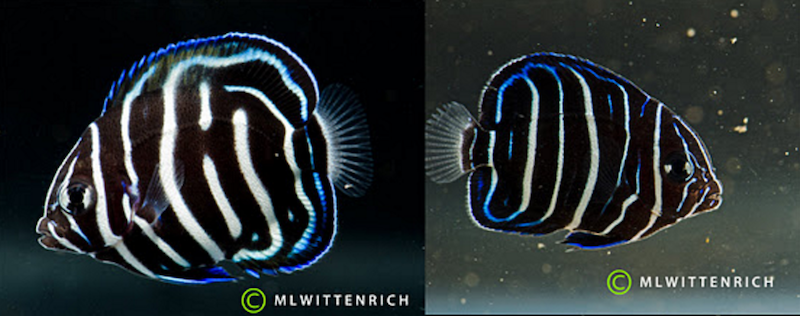We didn’t see this new development coming back in December, but leave it to Dr. Matthew L. Wittenrich to recently second guess the species identification on some of the juvenile captive-spawned angelfish they managed to rear in late 2011, as posted on the Rising Tide Blog. Why is Dr. Witt second guessing the identification of his captive bred marine angelfish?
It turns out there was more swimming around in the Columbus Zoo and Aquarium with the Koran Angelfish broodstock. And now, well, some of the captive-bred offspring reared by the team at University of Florida’s Tropical Aquaculture Lab just aren’t looking quite like Pomacanthus semicirculatus, the Koran or Semicircle Angelfish. It turns out there are also adult Blue Ring Angelfish, Pomacanthus annularis, residing in the tanks where spawning occurred and eggs were collected. Based on genetic testing, they know that they’ve reared P. semicirculatus. However, just like when we held out hope that Todd Gardner had managed to rear both Liopropoma rubre and L. carmabi in one shot, now Dr. Wittenrich seems pretty convinced that there’s some P. annularis in the mix. But wait a minute. If the eggs were all from a single night’s spawning activity, and potentially both species were spawning, that means that there could even be HYBRIDS of P. semicirculatus X P. annularis in this mixed bag of juveniles!

Credit where credit is due, it was Tyler Albrecht who commented on my reposting of the Rising Tide Blog Post on Facebook who clued me in that yes, there is something significantly notable differences in the coloration. His observation? “I vote for Blue Ring. No tail markings.” Sure enough, I start pulling out Endoh’s angelfish book, Scott Michael’s angelfish book, and there are definitive differences between the caudal fins of each species’ juvenile.
Pomacanthus annularis juveniles have a clear to white caudal fin, with very little coloration extending into the tail, and the coloration seems to “end” with a “white stripe” in at least some photos. Meanwhile, juvenile P. semicirculatus have more of a “clear edged” tail, generally showing 50% or more covered in pigmentation, and that coloration ends with a black band. Try these Google Image searches for juvenile Pomacanthus annularis and juvenile Pomacanthus semicirculatus and see what you come up with.
Of course, the reality is that these captive bred angelfish are still quite small, far smaller than anything you’d see imported, so their coloration and patterning will continue to develop as they grow. Of course, if any of these juveniles are actually hybrids, that could only further make identification difficult as the juveniles could show intermediate traits of both parents. Guess Dr. Witt’s just going to have to raise up every last angelfish to maturity so he can figure out what he and his team really have!
So what do you think, here’s 6 photographs – which species are they? Do you think we’re looking at the simultaneous first rearing of Pomacanthus annularis in addition to P. semicirculatus? What does it mean if we also find hybrid offspring in the mix – that would assuredly be the first second man-made Pomacanthus hybrid (the first being Martin Moe’s hybrid of P. arcuatus X paru). I couldn’t find any wild-occuring hybrid records for P. annularis in my quick research.

Read more of the story, directly from the Rising Tide update!



